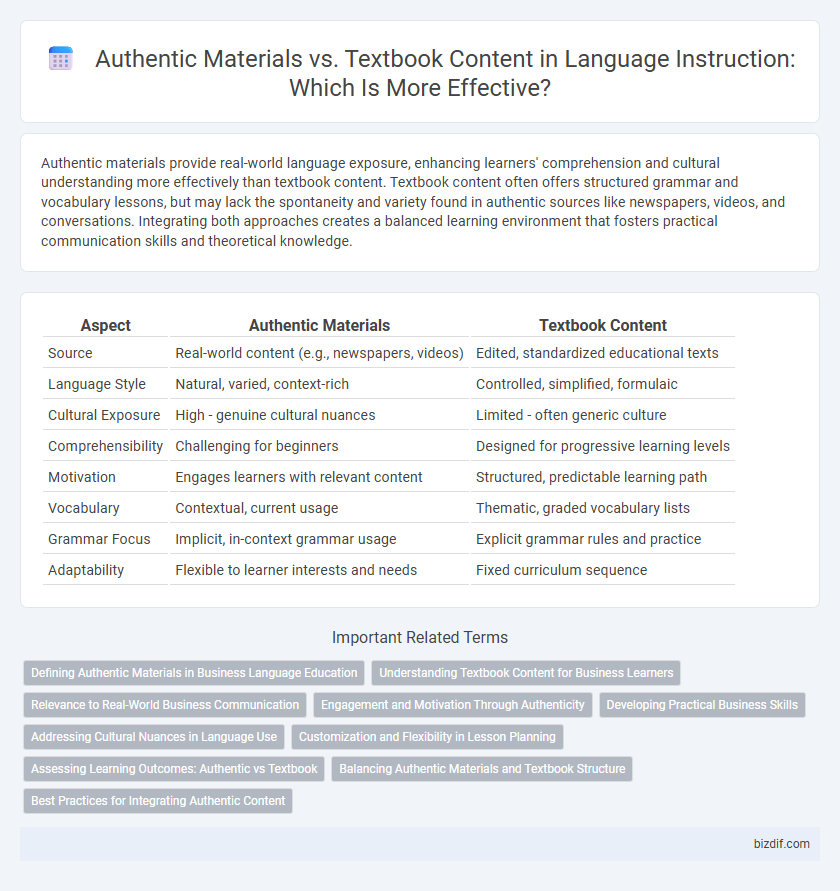Authentic materials provide real-world language exposure, enhancing learners' comprehension and cultural understanding more effectively than textbook content. Textbook content often offers structured grammar and vocabulary lessons, but may lack the spontaneity and variety found in authentic sources like newspapers, videos, and conversations. Integrating both approaches creates a balanced learning environment that fosters practical communication skills and theoretical knowledge.
Table of Comparison
| Aspect | Authentic Materials | Textbook Content |
|---|---|---|
| Source | Real-world content (e.g., newspapers, videos) | Edited, standardized educational texts |
| Language Style | Natural, varied, context-rich | Controlled, simplified, formulaic |
| Cultural Exposure | High - genuine cultural nuances | Limited - often generic culture |
| Comprehensibility | Challenging for beginners | Designed for progressive learning levels |
| Motivation | Engages learners with relevant content | Structured, predictable learning path |
| Vocabulary | Contextual, current usage | Thematic, graded vocabulary lists |
| Grammar Focus | Implicit, in-context grammar usage | Explicit grammar rules and practice |
| Adaptability | Flexible to learner interests and needs | Fixed curriculum sequence |
Defining Authentic Materials in Business Language Education
Authentic materials in business language education consist of real-world texts such as emails, reports, presentations, and market analyses produced by native professionals, reflecting current industry terminology and communication styles. These materials provide learners with practical exposure to the language as it is naturally used in specific business contexts, enhancing vocabulary acquisition and situational understanding. Unlike textbook content, authentic materials are dynamic and offer culturally relevant insights, making them essential for developing effective cross-cultural communication skills in global business environments.
Understanding Textbook Content for Business Learners
Understanding textbook content for business learners involves structured vocabulary, clear grammar explanations, and contextualized exercises tailored to professional scenarios. Textbook content ensures progressive skill development, standardized language input, and predictable learning outcomes critical for mastering business communication. This foundation supports learners in navigating complex corporate interactions and industry-specific terminology effectively.
Relevance to Real-World Business Communication
Authentic materials provide learners with exposure to current, real-world business language, enhancing practical communication skills essential for professional environments. Textbook content, while structured and systematic, often lacks the immediacy and contextual nuances found in actual business scenarios. Utilizing authentic materials bridges the gap between theory and practice, ensuring relevance in dynamic workplace communication contexts.
Engagement and Motivation Through Authenticity
Authentic materials, such as real-life articles, videos, and conversations, boost learner engagement and motivation by providing culturally relevant and context-rich content that mirrors actual language use. Unlike textbook content, which can feel contrived and repetitive, authentic resources foster intrinsic interest and practical application, making language acquisition more meaningful and dynamic. Exposure to genuine language contexts enhances comprehension and retention by connecting learners emotionally and cognitively to the target language culture.
Developing Practical Business Skills
Authentic materials expose learners to real-world business language, enhancing practical communication skills beyond the structured format of textbook content. These resources include emails, reports, and presentations from actual business contexts, fostering authentic interaction and cultural understanding. Textbook content provides foundational grammar and vocabulary, but authentic materials better prepare students for dynamic workplace scenarios.
Addressing Cultural Nuances in Language Use
Authentic materials such as films, news articles, and social media posts provide rich cultural context that textbooks often lack, enabling learners to grasp idiomatic expressions and social norms inherent to the target language. Textbook content tends to simplify language use, potentially omitting subtle cultural references and pragmatic cues essential for effective communication. Incorporating authentic materials in language instruction enhances cultural competence by exposing students to real-life language variations and contextual usage.
Customization and Flexibility in Lesson Planning
Authentic materials offer greater customization and flexibility in lesson planning by providing real-world language contexts tailored to student interests and proficiency levels. Unlike rigid textbook content, these resources enable instructors to adapt lessons dynamically, addressing diverse learning needs and promoting engagement. Integrating authentic texts enhances cultural relevance and practical communication skills, fostering more effective language acquisition.
Assessing Learning Outcomes: Authentic vs Textbook
Assessing learning outcomes using authentic materials often provides more accurate insights into a learner's practical language skills by simulating real-world contexts and interactions. In contrast, textbook content typically measures acquisition of structured grammar and vocabulary but may not fully capture communicative competence or adaptability. Empirical studies show that learners evaluated with authentic materials outperform those assessed solely through textbook-based tests in speaking, listening, and cultural understanding.
Balancing Authentic Materials and Textbook Structure
Balancing authentic materials with textbook content enhances language instruction by combining real-world context with structured learning objectives. Authentic materials expose learners to natural language use, cultural nuances, and varied vocabulary, while textbooks ensure systematic progression and comprehensive coverage of grammar and language skills. Integrating both resources maximizes engagement and reinforces language acquisition effectively.
Best Practices for Integrating Authentic Content
Integrating authentic materials, such as newspapers, videos, and social media posts, enhances language learning by exposing students to real-life language use and diverse cultural contexts. Best practices include aligning authentic content with learners' proficiency levels, setting clear learning objectives, and providing scaffolding to support comprehension and vocabulary acquisition. Textbook content should complement these resources by reinforcing grammar and foundational skills, creating a balanced and effective instructional approach.
Authentic materials vs Textbook content Infographic

 bizdif.com
bizdif.com